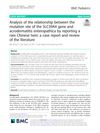Search
forLearn
2 / 2 resultslearn Osteopontin
signaling protein that, when suppressed, may grow hair by reducing inflammation and stem cell loss
Research
5 / 750 resultsresearch Congenital Zinc Deficiency from Mutations of the SLC39A4 Gene as the Genetic Background of Acrodermatitis Enteropathica
A Korean boy's skin and digestive symptoms were caused by a rare genetic disorder that affects zinc absorption, and he got better with zinc supplements.

research Functional Analysis of VDR Gene Mutation R343H in a Child with Vitamin D-Resistant Rickets with Alopecia
The R343H mutation in the VDR gene causes vitamin D-resistant rickets with alopecia by impairing specific gene activity.

research Prevalence of CYP21 Mutations and IRS1 Variant Among Women With Polycystic Ovary Syndrome and Adrenal Androgen Excess
Some women with PCOS have CYP21 mutations and IRS1 variants, but these genetic factors are not major contributors to PCOS.

research Analysis of the Relationship Between the Mutation Site of the SLC39A4 Gene and Acrodermatitis Enteropathica: A Case Report and Literature Review
New mutations in the SLC39A4 gene found in twins help understand the genetic cause of acrodermatitis enteropathica.

research Case Report: A Novel Splice-Site Mutation of MTX2 Gene Caused Mandibuloacral Dysplasia Progeroid Syndrome: The First Report from China and Literature Review
A new MTX2 gene mutation caused a severe genetic disorder in a young Chinese girl.
Community Join
5 / 10 resultscommunity So we have 20k dollars human like machines available but no new effective treatment for hairloss since finasteride :)
There have been no new effective hair loss treatments since finasteride, despite technological advancements. Current treatments include finasteride, minoxidil, and RU58841, with ongoing challenges and potential future solutions in research.
community I interviewed Kintor: GT20029 Clinical Trial Pictures. As well as KX826.
GT20029 and KX826 are promising hair loss treatments, with GT20029 increasing hair count and KX826 showing significant results. KX826 may be a good alternative for those who can't use finasteride or dutasteride, though results vary.
community Concerned about my child’s lack of density. Microneedling help?
A user humorously discusses their 10-month-old's hair loss, suggesting treatments like microneedling, minoxidil, finasteride, and RU58841. Replies include various satirical and exaggerated suggestions, emphasizing the post's satirical nature.
community 33 M - 3 months on Topical Fin, Topical Min 5%, Saw Palmetto and scalp massages
The conversation discusses a 33-year-old man's experience with hair regrowth after three months using topical finasteride, 5% minoxidil, saw palmetto, and scalp massages. Specific treatments for hair loss are being evaluated for their effectiveness.
community Why are low finasteride doses seen as highly ineffective, when studies show 0.05 mg/day to work?
The efficacy of low doses of finasteride to reduce scalp DHT, and whether studies showing a 61% reduction are reflected in actual results. Replies discussed hair growth as an unintended consequence of minoxidil and finasteride use, as well as self-selective bias, potential side effects, and that studies measure effectiveness by hair count changes rather than DHT inhibition.